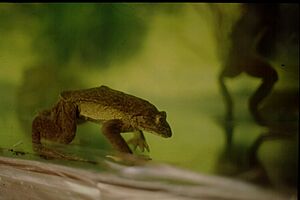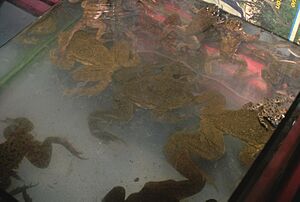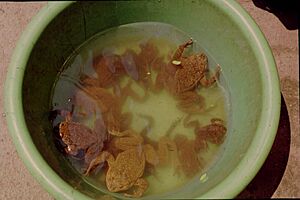Lake Junin frog facts for kids
Quick facts for kids Lake Junin frog |
|
|---|---|
 |
|
| Lake Junin frog in captivity | |
| Conservation status | |
| Scientific classification | |
| Synonyms | |
|
Batrachophrynus microphtalmus Werner, 1901 |
The Telmatobius macrostomus, also known as the Lake Junin frog or Andes smooth frog, is a very large and endangered type of frog. It belongs to the family Telmatobiidae. This frog lives completely in water. It is found only in lakes and rivers in the Andes mountains of central Peru. These areas are very high up, between 4,000 and 4,600 meters (13,100–15,100 ft) above sea level. Some of these frogs were moved to the upper Mantaro River, but we don't know if they are still there.
This frog is sometimes grouped with the Amable Maria frog (T. brachydactylus) in a different frog group called Batrachophrynus.
Where the Lake Junin Frog Lives and What It Looks Like
The Lake Junin frog lives only in water. It is found in lakes, rivers, streams, and canals that are connected to them. A famous lake where it lives is Lake Junín. It prefers places with lots of water plants. These areas are usually 1 to 5 meters (3–16 ft) deep. The water temperature in its home is usually between 7 and 17 degrees Celsius (45–63 °F).
This frog has smooth, dark brownish skin. It eats water snails, small shrimp-like creatures called amphipods, water insects like mayfly larvae, and small fish.
The Lake Junin frog is one of the biggest frogs in the world. It is the largest frog that lives only in water. It can grow up to 30 centimeters (12 in) long from its snout to its bottom. When stretched out, it can be 70 centimeters (28 in) long! It can weigh up to about 2 kilograms (4.4 lb). Its back legs alone can be over 40 centimeters (16 in) long.
Very large frogs are rare to find. Most adult frogs are about 12.4 to 17.3 centimeters (4.9–6.8 in) long. They usually weigh less than 0.5 kilograms (1.1 lb). Female frogs grow bigger than males. The baby frogs, called tadpoles, also grow very large. They can be up to 20 centimeters (7.9 in) long.
Why the Lake Junin Frog is in Danger
The Lake Junin frog used to be common, but now it is rare. It is considered an endangered animal by the IUCN. In 2012, scientists found very few of these frogs. This led some to suggest it should be called critically endangered.
There are several reasons why this frog is in danger:
- Hunting: People catch these frogs to eat them.
- New animals: Introduced trout fish eat the frogs.
- Pollution: Water pollution from mining, farming, and human waste harms the frogs.
- Water changes: The Upamayo Dam changes the water levels, which affects the frog's home.
These problems have also harmed the native Orestias fish. These fish used to be a big part of the frog's diet.
Some frog diseases, like chytridiomycosis and Ranavirus, have caused other frog types to die. While not yet confirmed in the Lake Junin frog, mass deaths have happened before. A very large number of frogs died in 1996, but the reason is still unknown.
Much of the frog's home is in protected areas. However, this protection is not enough. Local and national groups are working to help. They have started projects to watch and protect the frogs. They also teach people living near the frogs about how to help.
In 2008, a program started to breed these frogs in captivity. It created thousands of tadpoles, but this program stopped in 2012. Now, there are plans to try breeding them again. This will happen at the Huachipa Zoo in Lima. This plan comes after good results with breeding the related Titicaca water frog in captivity.
See also
 In Spanish: Rana de Junín para niños
In Spanish: Rana de Junín para niños
- Goliath frog (Conraua goliath) – the world's largest frog from Africa
- Helmeted water toad (Calyptocephalella gayi) – a very large aquatic to semi-aquatic species from Chile




